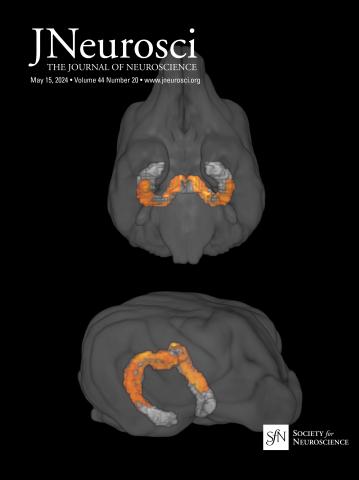视杆细胞主导的中视条件对早期视觉皮层空间求和与环绕抑制的影响
IF 4.4
2区 医学
Q1 NEUROSCIENCES
引用次数: 0
摘要
中视(暗光)条件在日常环境中非常普遍,但大多数人类视觉研究都是在理想化的光视(亮光)条件下进行的。电生理学研究表明,在中视条件下,编码对比度的视网膜神经节细胞感受野会扩大中心宽度,同时减弱周围抑制。这些视网膜改变通过增加求和区来增强光捕捉能力,但却限制了空间分辨率。然而,中视条件对人类大脑皮层空间整合机制的影响仍不清楚。为了解决这个问题,我们研究了中视条件如何影响早期视觉皮层处理,特别是空间求和与环绕抑制。通过两项实验,我们获取了 11 名正常视力的男女参与者在光视和中视条件下视觉 V1 - V3 区域的 fMRI BOLD 反应。第一项实验估计了群体感受野(pRF)的特性,第二项实验则评估了皮层环绕抑制。此外,还测量了光视和中视心理物理环绕抑制、对比敏感度功能(CSF)和视觉敏锐度。在皮层水平上,中视条件与较小的 pRF 大小相关,而环绕抑制仍然很强。在知觉水平上,中视条件导致敏锐度降低、CSF降低和抑制减弱,与观察到的皮层效应不同。重要的是,个体差异将这些发现联系在了一起:中视力下降较多的参与者也表现出早期视觉皮层环绕抑制下降较多,强调了其在对比度编码和空间分辨率中的作用。总之,我们的fMRI研究结果与视网膜电生理学研究结果形成了鲜明对比,并表明早期视觉皮层可能采用了不同的机制(也许是补偿机制)来应对中视条件下视网膜输入的减少。 重要意义 声明 尽管中视(暗光)环境普遍存在,但其对人类视觉皮层处理的影响仍未得到充分研究。电生理学研究表明,中视条件会导致视网膜神经节细胞的感受野增大和周围抑制减弱,从而以牺牲空间分辨率为代价增强光和。我们利用 fMRI 和心理物理测量,研究了中视条件如何影响早期视觉皮层的空间求和与环绕抑制。我们发现,在中视条件下,群体感受野变小,而皮层的环绕抑制仍然很强。然而,个体差异揭示了中视视力损伤与 V1 环绕抑制变化之间的相关性。这些发现与视网膜电生理研究结果形成鲜明对比,表明潜在的皮质细化机制有助于在退化的观看条件下保持视觉功能。本文章由计算机程序翻译,如有差异,请以英文原文为准。
Impact of rod-dominant mesopic conditions on spatial summation and surround suppression in early visual cortex.
Mesopic (dim light) conditions are prevalent in everyday environments, yet most human vision research is conducted under idealized, photopic (bright) conditions. Electrophysiological studies suggest that under mesopic conditions, retinal ganglion cell receptive fields, which encode contrast, expand their center width while diminishing surround inhibition. These retinal modifications enhance light capture by increasing the summation area but they limit spatial resolution. However, the impact of mesopic conditions on human cortical spatial integration mechanisms remains unclear. To address this, we investigate how mesopic conditions affect early visuocortical processing, specifically spatial summation and surround suppression. Across two experiments, we acquired fMRI BOLD responses from 11 normally-sighted participants of both sexes under photopic and mesopic conditions in visual areas V1 - V3. The first experiment estimated population receptive field (pRF) properties while the second experiment assessed cortical surround suppression. Photopic and mesopic psychophysical surround suppression, Contrast Sensitivity Function (CSF), and visual acuity were also measured. At the cortical level, mesopic conditions were associated with smaller pRF sizes, while surround suppression remained robust. At the perceptual level, mesopic conditions led to reduced acuity, lower CSF, and weaker suppression, diverging from the observed cortical effects. Importantly, individual differences linked these findings: participants who exhibited greater mesopic reductions in visual acuity also showed larger decreases in early visuocortical surround suppression, underscoring its role in contrast coding and spatial resolution. Altogether, our fMRI findings contrast with retinal electrophysiology and suggest that early visual cortex may employ distinct, perhaps compensatory, mechanisms in response to reduced retinal input under mesopic conditions.Significance Statement Despite the prevalence of mesopic (dim light) environments, their impact on human visuocortical processing remains understudied. Electrophysiological studies suggest that mesopic conditions lead to larger receptive fields and reduced surround inhibition in retinal ganglion cells, enhancing light summation at the cost of spatial resolution. Using fMRI and psychophysical measurements, we investigate how mesopic conditions impact spatial summation and surround suppression across early visual cortex. We find that under mesopic conditions, population receptive fields become smaller, and cortical surround suppression remains robust. However, individual differences revealed a correlation between mesopic visual acuity impairment and changes in V1 surround suppression. These findings contrast with retinal electrophysiological findings, pointing to potential cortical refinement mechanisms that help preserve visual function under degraded viewing conditions.
求助全文
通过发布文献求助,成功后即可免费获取论文全文。
去求助
来源期刊

Journal of Neuroscience
医学-神经科学
CiteScore
9.30
自引率
3.80%
发文量
1164
审稿时长
12 months
期刊介绍:
JNeurosci (ISSN 0270-6474) is an official journal of the Society for Neuroscience. It is published weekly by the Society, fifty weeks a year, one volume a year. JNeurosci publishes papers on a broad range of topics of general interest to those working on the nervous system. Authors now have an Open Choice option for their published articles
 求助内容:
求助内容: 应助结果提醒方式:
应助结果提醒方式:


